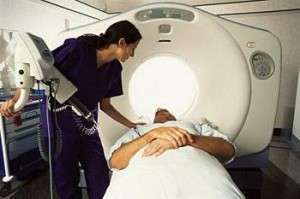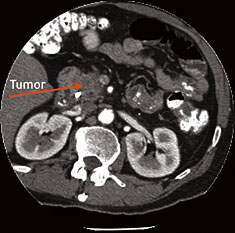
On This Page:
- What Is CT Imaging?
- Why Use CT?
- What Are Some CT Scan Types?
- How Should You Prepare for a CT Scan?
- What Happens During a CT Scan?
- What Can You Expect After a CT Scan?
- What Are the Possible Side Effects?
What Is CT Imaging?
Computed tomography (CT), also called computerized axial tomography (CAT), is a procedure used to create 3D body images. CT scans help doctors diagnose and treat medical conditions such as pancreatic cancer.
Before a CT scan, doctors give patients a contrast dye as a drink or IV. This helps highlight certain areas, like the stomach, bowels, blood vessels and organs.
During a CT, the patient lies still on a table. A donut-shaped scanner moves around the body to take many X-ray images. A computer joins all the pictures to create 3D images.
Why Use CT?
Doctors commonly order CT scans if they think a person may have pancreatic cancer. The images often help doctors find out if they can remove the tumor through surgery or if it has metastasized (spread to other areas of the body).
Unlike a basic X-ray which shows only bones, CT images show bones, blood vessels, muscles and organs. In pancreatic cancer, CT scans are used to:
- Find a tumor
- Figure out the size and location of a tumor and whether it has spread to other areas
- Guide a biopsy (the removal of tumor cells or tissue for examination)
- Help plan for surgery or radiation therapy
- Check whether the tumor is responding to treatment
What Are Some CT Scan Types?
Radiologists have developed specific CT techniques to get high-quality pancreas, liver and blood vessel images. These techniques are called pancreatic protocols. This is the preferred CT scan type for diagnosing pancreatic cancer. If a pancreatic protocol CT is not available, a high-quality CT scan may work.
Another type is the combined positron emission tomography – computed tomography (PET-CT). PET-CT scanning joins two imaging tests, the PET and CT, into one procedure. The combined scans may provide doctors with more information about the tumor’s location and whether it has grown or spread.
This combined technology is not at all medical facilities. PET-CT is not a replacement for high-quality, contrast-enhanced CT or magnetic resonance imaging (MRI) scans. But doctors may prefer a patient get a PET-CT along with these tests. Patients can check with their health insurance provider to see if their plan covers the combined PET-CT scan.
For more information about pancreatic cancer diagnosis and imaging tests, contact PanCAN Patient Services.
How Should You Prepare for a CT Scan?
The healthcare team gives the patient instructions before a CT procedure. In general, the patient should wear comfortable, loose-fitting clothing to the appointment.
Patients also need to remove all metal objects, including jewelry, eyeglasses, dentures or hair clips before the procedure. The radiation technician may provide a gown to wear during the scan.
Doctors may give patients a contrast dye to drink 60-90 minutes before the scan. If so, patients may not eat or drink anything except for the contrast liquid for several hours before the procedure.
Patients should tell the doctor if they are allergic to the contrast dye, which is made of barium, iodine or other substances. The doctor tells the patient whether to continue taking regular medicines before the CT scan.
What Happens During a CT Scan?

Marked area on CT scan shows a pancreatic tumor.
Patients lie very still on a table during their CT scans and may need to hold their breath for short time periods. Doctors may use straps or pillows to help patients stay in the correct position throughout the exam.
The technician controls the CT scan from a nearby room where they can see, hear and talk to the patient.
During the CT scan, the table moves slowly through the machine while the donut-shaped CT scanner turns around the body and takes X-ray images. Depending on the scanner, the rotating X-ray beam may cause some noise.
A CT scan usually lasts 15-60 minutes and is a painless procedure. For patients who are claustrophobic (afraid of closed-in spaces), the doctor may offer a mild sedative to help keep them calm.
What Can You Expect After a CT Scan?
The radiation technologist checks that the scanner captured high-quality images. If patients took a sedative, they should have someone else drive them home.
It may take several days to learn the results from a CT scan.
What Are the Possible Side Effects?
CT scans are not painful and have very few risks. There may be some discomfort from remaining still during the procedure.
If patients get the contrast dye through IV, they may feel a slight pin prick and warmth where the needle enters the vein. If patients drink the contrast substance, they may find the taste unpleasant and experience slight stomach discomfort.
Some patients are allergic to the contrast dye. In these cases, patients can use other imaging tests, such as an MRI.
A mild allergic reaction may cause itching, hives or small bumps on the skin. A more serious allergic reaction may cause difficulty breathing or swelling of the throat or other body parts. Patients should notify the technician immediately if they experience any of these symptoms during or after the procedure.
CT scans use X-rays, a form of radiation. Repeated radiation exposure may be a concern when patients get CT scans for screening and surveillance. Patients should discuss the risks and benefits with their healthcare team.
We’re Here to Help
For more information about pancreatic cancer diagnosis, CT scans or other imaging tests, contact PanCAN Patient Services.
Other Imaging Tests
Magnetic Resonance Imaging (MRI)
Positron Emission Tomography – Computed Tomography (PET-CT)
Endoscopic Retrograde Cholangiopancreatography (ERCP)
Information reviewed by PanCAN’s Scientific and Medical Advisory Board, who are experts in the field from such institutions as University of Pennsylvania, Memorial Sloan-Kettering Cancer Center, Virginia Mason Medical Center and more.
Information provided by the Pancreatic Cancer Action Network, Inc. (“PanCAN”) is not a substitute for medical advice, diagnosis, treatment or other health care services. PanCAN may provide information to you about physicians, products, services, clinical trials or treatments related to pancreatic cancer, but PanCAN does not recommend nor endorse any particular health care resource. In addition, please note any personal information you provide to PanCAN’s staff during telephone and/or email communications may be stored and used to help PanCAN achieve its mission of assisting patients with, and finding cures and treatments for, pancreatic cancer. Stored constituent information may be used to inform PanCAN programs and activities. Information also may be provided in aggregate or limited formats to third parties to guide future pancreatic cancer research and education efforts. PanCAN will not provide personal directly identifying information (such as your name or contact information) to such third parties without your prior written consent unless required or permitted by law to do so. For more information on how we may use your information, you can find our privacy policy on our website at https://www.pancan.org/privacy/.





